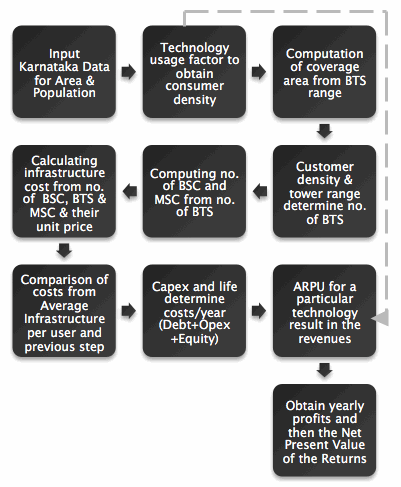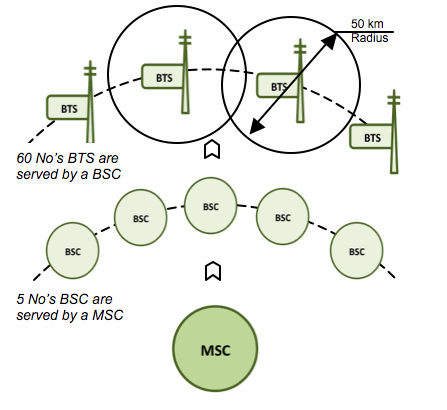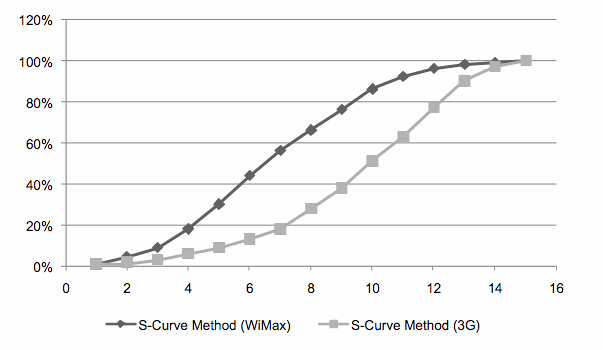Technology Wars: Competition Dynamics of the Wireless Spectrum in India
Faculty Contributor: S. Chandrashekar, Professor
Student Contributors: Gaurav Dharmadhikari, Sumit Sharan
The telecom industry is always in a state of flux with rapidly advancing technologies competing with each other for a share of the market. The most recent development is the war between 3G and WiMax. Major players in the global arena are aligning themselves with one or the other of these two emerging standards. On any given day, the business section of newspapers carry several articles describing how companies are lining up in the 3G-WiMax battle. This paper examines in detail the technology options before existing and new service operators and how investments in these would provide them with a competitive edge in an ‘anywhere, anytime’ access industry.
Technology change poses major challenges to existing companies. It also provides opportunities for new entrants into the industry. These dynamics of change and adaptation are most visible in the telecom industry. The opening up of the market and the changes in the regulatory framework in India has created a very competitive telecom industry in India. There is always pressure on the service providers to increase average revenue per user (ARPU). The transformational nature of the mobile technology in the world makes analysis of this space very interesting. The mobile set is undergoing a sea change. From a device meant for voice communication it is being transformed into a device that carries out multiple functions. It is precisely because of these reasons that the emerging new technologies have shaped themselves to serve both voice and data capabilities. 3G and WiMax are both emerging as potential competing technologies. As the battle for better data and voice services builds up, the decision for the telecom operators on what technologies to choose becomes even tougher since strong consortiums back both the 3G and WiMax Technologies.
The Contenders: 3G and WiMax
Currently, 2G Networks are the base technology for voice communication. The two main standards included under 2G are the GSM and the CDMA. The emerging 3G network boasts of super voice quality as compared to 2G and is a unified standard model based on a W-CDMA technology. While 2G networks transferred information at 16 kilo bits per second (kbps), the 3G technology can transfer data at rates of over 2 Mbps.
The WiMax standard was conceived as a technology mainly meant for data transfer and high speed internet connections. With the advent of the Voice over Internet Protocol (VoIP), WiMax has begun to serve many customers with both voice and data services. WiMax connections have the capabilities to transfer data at rates as high as 35 Mbps. This battle that was beginning to change the global mobile landscape was not very relevant in the Indian context a few months back because of the regulatory requirements that did not allow voice transfer over the internet. A recent ruling by TRAI has removed all restrictions over internet telephony. This change makes WiMax and 3G competitors in the Indian mobile landscape.
Evolution of Technology
The mobile space has seen a rapid development of 4 generations of technologies, the First Generation or 1G, the 2G, the Evolved 2G or 2.5G and the 3G. Each generation is associated with different standards. The development of the WiMax technology started in parallel with the 2G/3G standards but concentrated mainly on data. However the development of the VoIP has converted this data standard into a technology that can also provide voice services.
Third Generation or 3G
A massive evolution of the technology has come into existence in the form of the 3G technologies which are under the IMT2000 standard. High speeds of up to 4 Mbps on the uplink can be achieved along with the greater network capacities due to better spectral efficiencies.
As with every technology, the superior spectral efficiencies and the data and voice transfer speeds come at a price. 3G can provide the user an experience that he has never received in terms of data quality and voice signal. Thus, 3G has the potential to become big. 3G will in turn merge the customer base of both the standards by laying out proper migration paths for both the standards.
WiMax
WiMax is always spoken of as the technology that can enable the last mile wireless access to the customer. Many businesses are actually looking at WiMax for the sole purpose of high speed data access to their offices.
| |
WiMax |
3G |
| Development Motivation |
Broadband data service |
Voice Services |
| Multiplexing technology |
OFDM |
TDMA/ CDMA |
| Data Rate |
16 Mbps |
4 Mbps |
| Degree of Development |
Initial Stage |
Roll out stage |
| Company backing |
Intel, Motorola |
Qualcomm |
Exhibit 1.
Comparison of WiMax and 3G
WiMax has been proven to have superior spectral efficiencies and higher data transmission rates as compared to the 3G networks. A comparison of the two technologies indicates their substitutability which needs to be understood in greater detail. Although the highlights have been shown in Exhibit 1, a more comprehensive methodology for understanding the two technologies required the development of a model.
Modeling 3G & WiMax
A model was developed on Microsoft Excel to simulate the financials for a company that attempts to setup its wireless network in the state of Karnataka, India. The model will be used to predict the profitability and also the growth potential of the two technologies. The flowchart provided in Exhibit 2 illustrates the methodology for the model.
 Exhibit 2.
Flowchart detailing a model for computing the profitability analysis of the two technologies
Exhibit 2.
Flowchart detailing a model for computing the profitability analysis of the two technologies
Inputs
The Inputs section is divided into four main data sets.
State Data
The model assumes that an operator needs to setup a network so as to cover each customer in the state of Karnataka. To simulate the same, the model uses secondary information on the population in the state.
Technology Information
This section takes inputs on parameters that are specific to each technology. The initial data collected is that of the technology usage factor. It is defined as the fraction of the population that adopts a particular technology. Subsequent information that is provided as input is the range of the tower. The range determines the tower area coverage.
Each tower consists of sectors, channels, and subscribers. These are multiplied to obtain the capacity in Erlang for the tower. One Erlang is the equivalent of one call (including call attempts and holding time) in a specific channel for 3600 seconds per hour. This information when combined with the usage of the customers will result in the maximum customer carrying capacity for a BTS (Base Transmission Station). This results in a capacity of 192 Erlang for each BTS for a 2G or 3G technology. In the 2G standard, each customer is allowed a bandwidth of 16 kbps (kilobits per second) while the same is upgraded to nearly 384 kbps-2Mbps in the 3G standard.
The network setup costs in the model are estimated based on the independent costs of the BTS, BSC (Base Service Station) and the MSC (Main Service Station). The initial capital expenditure involved in setting up a tower is nearly Rs. 25 lakhs, while it amounts up to Rs. 50 lakhs for a BSC. Constructing a MSC requires Rs. 7 crores. In Karnataka, a major operator requires 9 MSCs to cater to nearly 45 BSCs which in turn service 60 to 70 BTSes each. For setting up the WiMax networks, the Capital Expenditure amounts to $75000 per cell site. Exhibit 3 illustrates a concise and diagrammatic model of the way BTSes, BSCs and MSCs are arranged, while shedding light on the secondary data procured for the study.
|
Karnataka State Data
|
| Land Area |
191791 sq kms |
| Population |
52850562 people |
|
Range of Telecom towers
|
| 2G/3G |
40 kms |
| WiMax |
~50 kms |
|
Model
|

|
Exhibit 3.
Secondary data analysis and the computation of the telecom towers’ range in the Model
Customer Information
The most important contribution from the customers from the point of view of a network operator is the average revenue per user (ARPU). The same is incorporated in the model to predict the future cash flows for the operator. Both 3G and WiMax are meant to transmit data and voice as well. This implies that the ARPU for the next generation technologies will be a more than the 2G technologies as there will always be some revenue earned from the data services.
Financial Information
This section in the input sheet takes in the usual Debt: Equity ratio for Telecom Operators. Major infrastructure projects usually have a near 70:30 ratio which signifies the lower costs to service debt as compared to equity. The Costs to service Debt and Equity are assumed at 10% and 14% respectively.
Revenue Model
This section simulates the revenue and earnings model for an operator in the next generation domains. The life of the technology is assumed to be 15 years in the calculation for this model. Operations and maintenance (O&M) costs are estimated as percentages of the initial capital expenditure. The output of the model also runs sensitivity on the O&M costs and estimates its relation with the returns obtained by the company. All the above costs include the total costs that are borne by the company each year which include the costs of debt repayment, the return on debt and equities and the O&M costs.
The revenue for the operator is estimated by computing the product of the ARPU and the number of subscribers each year. The number of subscribers adopting the technology is modeled as an S-Curve. The model assumes that there are certain early adopters for the technology which are followed by the imitators. The study has resulted in some key findings that are mentioned in the sections to follow.
Key Findings
Running a sensitivity analysis on the parameters has resulted in three main inferences, dealing with the independent sustenance of these technologies.
Proposition 1
“The cost of setting up a brownfield 3G is less than greenfield WiMax which in turn is less than greenfield 3G”
From the outputs of the model detailed above, it can be inferred that the total infrastructural cost for setting up a greenfield 3G Network throughout Karnataka would be costlier than that for a greenfield WiMax Network. The main reason for this cost efficiency is due to the savings that result because of the single consolidated cost of BSC-BTS unlike 3G which requires separate BSCs and BTSes.
On the other hand when it comes to a brownfield environment where there are existing networks in place, the 3G networks can obtain synergies close to 70% of the cost of a greenfield 3G. This becomes an attractive proposition for an existing 2G operator who wants to upgrade to the next generation technologies.
The primary reason for this cost saving of brownfield 3G is due to the synergies achieved while using the existing BSC and BTS infrastructure of 2G networks. For upgrading an existing 2G BTS into a 3G network compatible BTS, a converter box needs to be installed. Similarly a Radio Network Converter needs to be set up at the existing 2G BSC facility to make it compatible with 3G networks.
Proposition 2
“Data services offered by WiMax have to be markedly superior vis-a-vis 3G in order to justify any investments in it, considering the same ARPU from a user”
Analysis using an S curve adaptation rate shows that because of higher capital expenditure associated with greenfield WiMax in comparison to brownfield 3G, WiMax would require a much higher initial adaptation rate compared to 3G, to justify any investment. Since the current USP (unique selling point) of WiMax compared to 3G is the Data Services offered by it, they have to be markedly superior to achieve greater adaptation rates.
Our analysis shows if the initial adaptation rate of WiMax is 3 times compared to 3G in the initial 5 years, then an investor can earn an ROI of 35% compared to 30% ROI of 3G. Exhibit 4 indicates a comparison of the Adaptation rates as obtained from the model for the two technologies assuming a constant ARPU. The constant ARPU indicates that the technologies are perfectly substitutable.
 Exhibit 4.
Comparing Adaptation rates at same ARPU
Exhibit 4.
Comparing Adaptation rates at same ARPU
Proposition 3
“Value Added Services offered by WiMax has to be markedly superior compared to 3G to earn significantly higher ARPU, assuming same adaptation rates”
For a similar adaptation profile in WiMax and 3G, WiMax has to have an ARPU of 1.7 times as compared to 3G for justifying an investment in greenfield WiMax networks. This assumes a 5% premium on return on investment in greenfield WiMax as compared to brownfield 3G. As mentioned before returns on investments in brownfield 3G is 30%.
Exhibit 5 indicates the profile of the returns that WiMax will need to generate so as to justify its higher initial capital expenditure when compared to the 3G networks which can take advantage of the synergy from the existing 2G networks.
 Exhibit 5.
Comparing Earnings at same adaptation rate
Exhibit 5.
Comparing Earnings at same adaptation rate
Conclusion
3G has a superior voice quality as compared to WiMax with a reasonable service on the data front. On the other hand, WiMax is the best bet for data intensive industries like BPOs and KPOs. The recent judgment on the legitimacy of the VoIP services in India has made room for WiMax’s voice services as well. It has been proven that in the areas where there is an upgrade possible from the 2G networks, the 3G technology is more cost effective. This is relevant in the urban areas where the networks can be upgraded and with an inexpensive change in the handset models, the customers can enjoy the advantages of the 3G data services as well. In rural areas, where access or connectivity is still an issue, WiMax has been proven to be a better proposition.
Another way to look at the situation is through a cooperation model where each technology can make use of its relative advantage to serve a particular market. BSNL’s strategy is to invest in both the technologies and create a network of 3G services with WiMax hotspots taking the burden of data in areas with higher data rates. Higher data rates are predominantly required in urban and industrialized areas. This means that both 3G and WiMax can cooperate to provide the best services in data & voice.
Brandenburger (1996) summarizes this effect as the Coopetition model wherein the technologies can behave as competitors and cooperators, depending on the environment. The urban areas are pretty much the cooperative playgrounds for these technologies, where 3G and WiMax can pool in their resources to give the best benefits to the consumers, while the rural areas can play the quintessential competitive turfs for both of them. The digital divide will eventually bridge out when 3G develops cost efficiency in its initial investment, while WiMax develops handsets that can be used as mobiles.
Contributors
S. Chandrashekar is a Professor in the Corporate Strategy and Policy Area at IIM Bangalore. His areas of expertise are mainly Technology Management and R & D Management. He holds a B.Tech, from IIT-Madras in Metallurgy and a Post Graduate Diploma in Business Management (PGDM) from IIM-Calcutta. He can be reached at schandra@iimb.ernet.in
Gaurav Dharmadhikari (PGP 2007-09) holds a B.Tech degree in Petroleum Engineering from Indian School of Mines University (ISMU) Dhanbad. He can be reached at gauravd07@iimb.ernet.in
Sumit Sharan (PGP 2007-09) holds an M. Tech and B.Tech (Majors. in Electronics and Electrical Communication Engineering and B.Tech (Minor) in Computer Science and Engineering from Indian Institute of Technology (IIT) Kharagpur. He can be reached at sumits07@iimb.ernet.in.
Special acknowledgement is also due to Mr. Rajkumar Upadhyay, DGM and CIO, BSNL Bangalore for his valuable suggestions and comments on the paper.
Keywords
Strategy, Telecommunications, 3G, Wimax, India
References
- Alvarion Networks, A White Paper- Comparison of 3G and WiMax Networks , http://www.alvarion-usa.com/upload/contents/291/Comparing_WiMAX_vs_3G_White_Paper.pdf. Last accessed on June 27, 2009.
- 'Select Socio-Economic Indicators for all states and India', http://www.tn.gov.in/deptst/EcoIndAllStates.htm. Last accessed on April 18, 2009.
- Wookbong Lee and Binchul Ihm, IEEE 802.16 Broadband Wireless Access Working Group, http://www.ieee802.org/16/tgm/contrib/C80216m-07_007.pdf. Last accessed on April 18, 2009.
- 'Spectrum Analysis - The Critical Factor in 3G versus WIMAX', 2006, http://www.frontpagepr.com/clients/maravedis/research_report_toc/3G_vs_wimax_spectrum_toc_1-2006.pdf. Last accessed on April 18, 2009.
